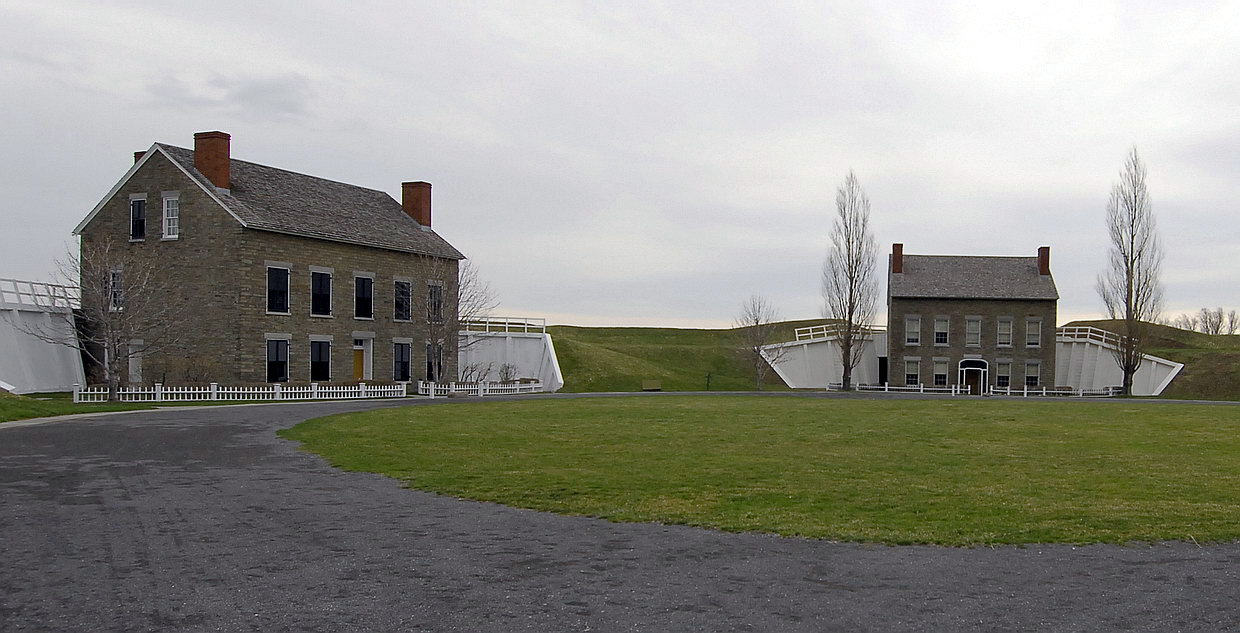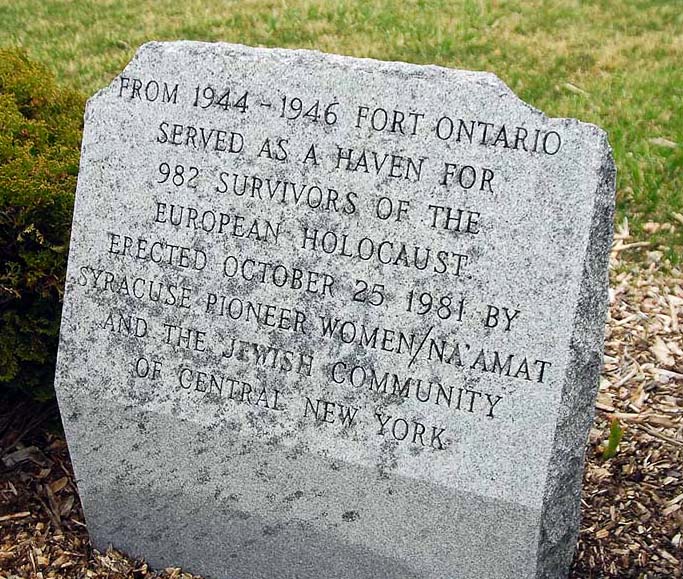
2006-04-08-Fort Ontario, New York
| Nowell C. Wisch & Diana "DJ" Barliant
|
A visit to a Holocaust
refuge in upstate New York
Jewishsightseeing.com,
April 8, 2006
 |
2006-04-08-Fort Ontario, New York |
|||
|
|
|
|||
|
The Wandering Jews of
Ocean Beach A visit to a Holocaust refuge in upstate New York Jewishsightseeing.com,
April 8, 2006 |
| This is the first in a series of stories about places in the United
States that have significance in Jewish history. We "Wandering Jews"
from the Ocean Beach neighborhood of San Diego crisscross the country on
business and pleasure and look for places not too far off the beaten track
that have interest to our people. The series will be as irregular as the
authors, but interesting enough to look for and anticipate. Thanks for joining
us on our travels! (Nowell and DJ) Story and Photos by Nowell C. Wisch and Diana "DJ" Barliant  OSWEGO, N.Y.—There is an important historical site sitting on the shore of Lake Ontario in upstate New York in the nice sized town of Oswego, N.Y. Oswego is typical of an upstate village that has become a regional commerce center. There are colleges, community centers, tall building which one could leap in a single bound and the historic Fort Ontario, the site of today’s find. Prior to World War II, most nations ignored the evidence that Hitler was embarking on “The Final Solution." As more and more people were rounded up in Germany and incarcerated in “The Camps,” the leaders of the Western world simply ignored the plight of what was to become more than 11 million victims of the heinous project, 6 million of them Jews. Much has been written and filmed about the callousness shown by American and British politicians and the effect of their utter disregard for the events being reported from Europe. An exception to this policy of neglect was one small incident that began on August 4, 1944.  After
repeated refusals to allow Jewish refugees into the country because there was
no coherent immigration policy that would accommodate them, the Roosevelt
administration finally allowed 928 escapees from eleven different regions in
Europe to enter the US and take residence at Fort Ontario. After
repeated refusals to allow Jewish refugees into the country because there was
no coherent immigration policy that would accommodate them, the Roosevelt
administration finally allowed 928 escapees from eleven different regions in
Europe to enter the US and take residence at Fort Ontario.It was an unlikely place to house Holocaust escapees. The fort’s history, dating back to 1755, had played key roles in the French and Indian Wars as well as the War of 1812. In 1944, Fort Ontario occupied more than 125 buildings which were home to officers and enlisted men of several different US Army units. However, because of its remote location and its available facilities, it seemed the perfect place to park 156 children and 826 adult Jews. The residents of the Fort Ontario camp did not fit into their new surroundings. They came from 18 different countries and spoke many different languages. Consequently, a school was established to teach them American English as well as introduce them to the customs of the United States. As is typical of Jewish refugees everywhere, the students were motivated and engaged. They wanted to learn as much as possible about their new land and surroundings. To help pass the time, their schedule included recreation and social activities as well as the formal schooling. The curriculum also included theatrical productions and vocational training. The refugees at Fort Ontario had mixed memories of the shelter. While they were thankful to be safe, they still felt confined. Upon reaching America, a place they envisioned to be completely free, they continued to be held behind barbed wire and allowed to leave the camp only with a special permit. They could not visit relatives or serve in the army. At the end of the war, their status continued in limbo. Because of bickering factions within the Truman Administration over their status as immigrants, they were interred until January 1946. When the decision was made to allow them to become citizens, the camp quickly emptied and by February all of the Jewish refugees had dispersed from the Fort for the homes of families, friends or acquaintances.  Today
you can get a sense of what this period in our history looked like by visiting
Fort Ontario, which became a New York State Historic Site in 1949. It is open
for visitors during the late spring and summer months. There are tours of the
main complex and you can visit some of the historic out buildings which now
house various community groups and organizations. Today
you can get a sense of what this period in our history looked like by visiting
Fort Ontario, which became a New York State Historic Site in 1949. It is open
for visitors during the late spring and summer months. There are tours of the
main complex and you can visit some of the historic out buildings which now
house various community groups and organizations.We found The Safe Haven Museum and Educational Center in Building 22. The museum has a collection of numerous books, photos and articles detailing the activities and memories of the refugees. During the tourist season from late April through September, the Center is open Tuesday through Sunday from 11:00 am to 4:00 pm in Building 22. Admission is: Adults- $4.00, Seniors- $2.00 and Children 5-12 $1.00.
|